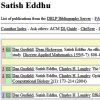| |

Daniel H. Huson. Split networks and Reticulate Networks. In
Olivier Gascuel and
Mike Steel editors, Reconstructing Evolution, New Mathematical and Computational Advances, Pages 247-276, Oxford University Press, 2007.
Keywords: abstract network, consensus, from rooted trees, from sequences, from splits, from unrooted trees, galled tree, hybridization, phylogenetic network, phylogeny, Program Beagle, Program Spectronet, Program SplitsTree, Program SPNet, recombination, reconstruction, split network, survey.
Note: similar to http://www-ab.informatik.uni-tuebingen.de/research/phylonets/GCB2006.pdf.
|
|
| |
|
| |
   
Dan Gusfield,
Vikas Bansal,
Vineet Bafna and
Yun S. Song. A Decomposition Theory for Phylogenetic Networks and Incompatible Characters. In JCB, Vol. 14(10):1247-1272, 2007.
Keywords: explicit network, from sequences, galled tree, phylogenetic network, phylogeny, Program Beagle, Program GalledTree, recombination, reconstruction, software.
Note: http://www.eecs.berkeley.edu/~yss/Pub/decomposition.pdf.
|
|
| |
|
| |
 
Patricia Buendia and
Giri Narasimhan. Sliding MinPD: Building evolutionary networks of serial samples via an automated recombination detection approach. In BIO, Vol. 23(22):2993-3000, 2007.
Keywords: from sequences, phylogenetic network, phylogeny, Program Sliding MinPD, recombination, recombination detection, serial evolutionary networks, software.
Note: http://dx.doi.org/10.1093/bioinformatics/btm413.
Toggle abstract
"Motivation: Traditional phylogenetic methods assume tree-like evolutionary models and are likely to perform poorly when provided with sequence data from fast-evolving, recombining viruses. Furthermore, these methods assume that all the sequence data are from contemporaneous taxa, which is not valid for serially-sampled data. A more general approach is proposed here, referred to as the Sliding MinPD method, that reconstructs evolutionary networks for serially-sampled sequences in the presence of recombination. Results: Sliding MinPD combines distance-based phylogenetic methods with automated recombination detection based on the best-known sliding window approaches to reconstruct serial evolutionary networks. Its performance was evaluated through comprehensive simulation studies and was also applied to a set of serially-sampled HIV sequences from a single patient. The resulting network organizations reveal unique patterns of viral evolution and may help explain the emergence of disease-associated mutants and drug-resistant strains with implications for patient prognosis and treatment strategies. © The Author 2007. Published by Oxford University Press. All rights reserved."
|
|
| |
    
Joanna L. Davies,
Frantisek Simancík,
Rune Lyngsø,
Thomas Mailund and
Jotun Hein. On Recombination-Induced Multiple and Simultaneous Coalescent Events. In GEN, Vol. 177:2151-2160, 2007.
Keywords: coalescent, phylogenetic network, phylogeny, recombination, statistical model.
Note: http://dx.doi.org/10.1534/genetics.107.071126.
Toggle abstract
"Coalescent theory deals with the dynamics of how sampled genetic material has spread through a population from a single ancestor over many generations and is ubiquitous in contemporary molecular population genetics. Inherent in most applications is a continuous-time approximation that is derived under the assumption that sample size is small relative to the actual population size. In effect, this precludes multiple and simultaneous coalescent events that take place in the history of large samples. If sequences do not recombine, the number of sequences ancestral to a large sample is reduced sufficiently after relatively few generations such that use of the continuous-time approximation is justified. However, in tracing the history of large chromosomal segments, a large recombination rate per generation will consistently maintain a large number of ancestors. This can create a major disparity between discrete-time and continuous-time models and we analyze its importance, illustrated with model parameters typical of the human genome. The presence of gene conversion exacerbates the disparity and could seriously undermine applications of coalescent theory to complete genomes. However, we show that multiple and simultaneous coalescent events influence global quantities, such as total number of ancestors, but have negligible effect on local quantities, such as linkage disequilibrium. Reassuringly, most applications of the coalescent model with recombination (including association mapping) focus on local quantities. Copyright © 2007 by the Genetics Society of America."
|
|
|
 - forked on GitHub.
- forked on GitHub.






























